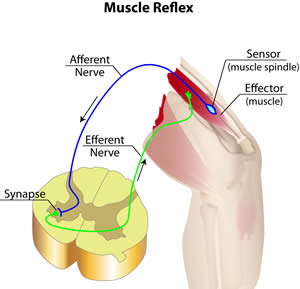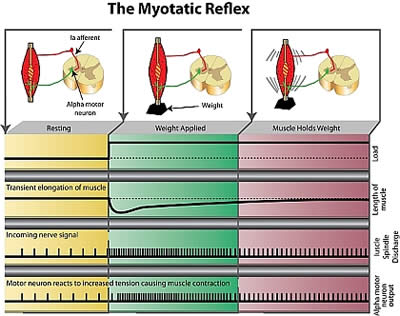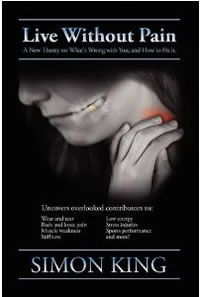Positive Health Online
Your Country

Reflex Reactions - Our Body's Rapid Defence Mechanism
listed in chiropractic, originally published in issue 176 - November 2010
If our awareness of the outside world comes from our senses, our reactions to the outside world are controlled by our reflexes. When we think of reflexes, we typically think of an unexpected reaction to an outside stimulus. We might duck in response to a loud sound, dodge if we see something coming towards us, retract if we touch something hot, or pull away if we stand on something sharp.
All these 'reflex' reactions occur when muscles contract in response to an obvious external stimulus.

Reflexes are, by definition, actions that occur before the brain is aware of what is happening. Reaction to a stimulus is processed in the spinal cord, bypassing brain control. Naturally, if movement results, the brain will become aware of such movement and can regulate it somewhat, but the brain cannot control it.
Reflexes usually have five (and always four) separate parts:
- A sensor;
- A sensory nerve that carries the message from the sensor to the spinal cord;
- An interneuron-a relay nerve (Some reflexes bypass the interneuron; others go via three or four interneurons.);
- A motor nerve that carries the message from the spinal cord to the muscle;
- A muscle fibre that contracts.
The Stretch (Myotatic) Reflex
The stretch reflex or myotatic reflex (sometimes myotactic reflex) is probably our body's most unrecognised and unappreciated defence mechanism. Forget about the immune system. When it comes to making it safely through the day, nothing comes close to the myotatic reflex.Imagine that a muscle is able to constantly monitor its own length and tension no matter what it's length, and is able to respond the instant it's length or tension changes. Without the myotatic reflex, controlled movement would be impossible.

The myotatic reflex starts in the muscle spindle which constantly and spontaneously produces an afferent impulse to the spine and therefore the brain - at a rate of at least 5-50 times per second. Any little change in tension or stretch in the muscle will increase this feedback to spine and produce an rapid increase in muscle tone.
One of the best-known myotatic reflexes is the knee-jerk reflex. You sit with your leg dangling towards the floor and your leg is tapped just below the kneecap. Hopefully, your foot will shoot out and then relax back to its starting point. This reflex's sensors are the muscle spindles located in the quadriceps, or thigh muscle. You will remember that these sensors constantly generate nerve signals.
As the tendon is tapped below the kneecap, a small but sudden stretch is felt by the spindles. The spindles respond by 'revving' the engine, i.e., suddenly increasing the frequency of messages to the spinal cord. The muscle spindle's increased rate of firing relays directly and indirectly to the anterior motor neurons.
The anterior motor neurons now have more sensory input, so their output suddenly increases. The muscle contracts, and, instantly, your foot shoots out. It is important to remember that the reaction in the knee is not a curiosity. This reflex occurs in ever voluntary muscle, everywhere in the body.
Not Just for Fun
This reflex does not exist simply for the amusement of doctors and young children. In life, this reflex works to protect our joints from injury.Imagine a gymnast landing on a mat after a somersault. With her legs bent, she is ready for impact. As her feet touch the mat, her knees bend further. The quadriceps muscle on the front of her thigh starts to stretch. Sensors within the muscle detect the speed and force of the stretch, and fire rapidly. The nerve from the muscle carries the massively increased rate of firing back to the spinal cord, where a direct connection is made to the nerves that control the tone (strength) of the quadriceps. The massive increase in nerve activity is transmitted straight back to the quadriceps, causing it to contract instantly.
The faster the muscle stretches, the faster the response will be. Failure to contract hard enough would cause the gymnast to end her leap sprawled on the ground; too much contraction, and she would be flung straight up in the air again.
The example of the gymnast teaches us that feedback from the stretch of a muscle dynamically alters the muscle strength output in a way that protects our joints and our bodies from injury. Most of us will never be doing somersaults, but we use those same reflexes every time we walk down stairs, jump off a chair, throw a ball, or bend over to pick up a pen.
Think back to the last time you jumped off a chair, or, if you haven't done it for a while, try it now. You may have had time to plan the landing, but did your planning really help? Most of the time, the landing is done on autopilot. Feedback from muscle spindles in your thigh told the motor neurons in your spine exactly how much force to generate so you could land without injury.
Constant Adjustment
Muscles constantly adjust their tone to control our movements. If you can, squat down on the floor right now. Don't hold onto anything. Just balance. Notice what is happening to your feet and ankles.Do you feel the tiny adjusting movements keeping you on balance? These movements are the result of reflexes coming from the muscles themselves. Those same reflexes are operating in every muscle, throughout your body, all day, every day.
Imagine you were walking across rocks and your foot suddenly slipped. The muscles holding your foot would be stretched very rapidly, causing the spindle cells to increase their rate of firing back to the spinal cord. Direct connections to the nerves that contract the muscle are increased, and the muscle suddenly fires, holding the foot, and preventing a sprain of your ankle ligaments.
The reflex that caused your foot to shoot out when the kneecap was tapped, and stopped our gymnast from collapsing on the floor, is actually the same reflex that keeps your ankle safe from sprain or strain while you walk.
24/7
Actually, it is unfortunate that the stretch - or myotatic - mechanism was ever called a reflex because most people link reflexes with one-off events, like the knee jerk. But the myotatic mechanism is unlike all other reflexes because it functions twenty-four hours per day, constantly monitoring and maintaining appropriate muscle tone.When we bend forward to pick up a pen off the ground, we often forget that muscles all the way up our spine are working to hold our weight, that our calf muscles are contracting to push our toes into the ground, and our neck muscles are active to hold our head up. When we pick up a chair or a bag of cement, the sensors in the muscles that move the vertebrae in our spine will have more or less tension placed upon them, and they will vary their output accordingly. As we lift the weight, the amount of tension in the muscles increases, and the muscles increase their power to hold our spine firmly.
These stabilizing muscles are vital for our joint function and safety. If the stabilizers don't work with enough speed or strength, then the joint is likely to be sprained, strained, or damaged. This can happen in one major accident, leading to strain or sprain. Or it can happen over years, causing the wear and tear we know as osteoarthritis.
The Withdrawal (Flexor / Polysynaptic) Reflex
The stretch, or myotatic, reflex is just one of the reflexes vital to our survival and safety. We also need the withdrawal reflex-the name given to the sequence of events that lifts your foot off a nail, pulls your hand from a hotplate, or causes you to flinch when tickled. It is often called the flexor withdrawal reflex, or the polysynaptic withdrawal reflex, but the simple 'withdrawal reflex' is very descriptive because it functions to move us away from danger.If we stand on a nail, pain sensors in our foot are activated, causing contraction of the hamstrings and calf muscles which lift our foot off the nail. Without such a reflex, we might carry on walking normally and do much more damage. The sensors in our feet respond not just to pain, but also to pressure and light touch. Notice the way we flinch when tickled, and find it difficult to walk with a pebble or other small object in our shoe.
If our gymnast were to land on a nail or sharp stone, feedback from the skin via the flexor withdrawal reflex would activate the hamstrings and cause the quadriceps muscle to be inhibited (switched off). Switching off the very muscles she needs to break her fall would cause her knees to buckle, and she would land in a heap on the floor - but she would not step hard on the sharp object.
More Than Danger Control
Proprioceptors in our skin detect pain, pressure, light touch, vibration, and temperature. All are linked to relevant muscles by the withdrawal reflex so that, should any of these sensors pick up a sudden change, the part that is threatened will be drawn away rapidly. You will probably recognize the withdrawal reflex in the feet (standing on a nail) and hands (pulling away after touching a hotplate), but it operates throughout the body. From the agony of biting on a stone to the hysterics of a child being tickled, the withdrawal reflex is always ready to prevent continued irritation, and it does so by altering muscle strength, activating some muscles and inhibiting others.But the flexor withdrawal reflex does more than just sense danger. The fast connections between sensors in our skin and our muscles help us with movement control. When we catch a ball, skin sensors will help us gauge its weight. This information is combined with information about the amount of tension on the biceps muscle. That combined information will then be interpreted instantly in the spinal cord so that the right amount of counterforce is generated to allow us to hold the object still, rather than dropping it or throwing it back into the air.

The Cause of Nearly All Injury
Our bodies are always resisting outside forces. Just walking down a step produces a force through our ankle, knee, and hip, which could cause injury if it were not for the ability of every muscle to assess the amount of tension being applied to it and act in a millisecond to resist that tension. Our muscles are always at the ready - willing and able to protect us from the certain injury that would otherwise accompany even such normal activities as walking, running, jumping, or sitting.By controlling the movement of joints, muscles prevent injury. Thus, if muscle tone or strength is lost, injury is more likely. Joints can be sprained or strained, muscles can be torn, cartilage can be ruptured, ligaments and discs can be torn; in fact, almost any injury is possible with a lack of muscle tone. Put another way, a lack of muscle tone is the cause of nearly all persistent injury.
Comments:
-
Eric Showes said..
I have a history of falls for years that has always been embarrassing.Even though I have been athletic and active my whole life, simple routine movements sometimes cause me to fall. For instance just walking on level ground with or without a raised area my foot might "stub" a step instead of landing properly and begin to fall. Sometimes I catch myself but too often I just fall. I get a feeling like I was stunned, my legs wobble and I try to react but I can't. It has happened on a tile floor or carpet, up or down stairs or a change in surfaces. I find myself looking down a lot so my foot doesn't drag or hit a different surfaces. Sometimes there's no change in the surface and I fall.It's very frustrating to say the least. I mentioned this to a doctor several years ago in my thirties but no answers or resolutions were provided. So I fall, get up angry at myself and keep going. I seriously injured myself 4 years ago and ruptured three cervical discs and bruised my spinal cord falling down four steps. I know this is a comment section but I'm looking for answers and direction.
-
Jacquie McKamey said..
My reflex is out of control Last night I had a reflex thad just about threw me out of bed.
-
Tracy said..
What could cause this to malfunction? My flinch response to dangerous outsidr stimulus does not work. People can jump in my face and i Don't feel fear or danger. I don't run or fight.
I use to react with violence, I would strike out but now nothing.
